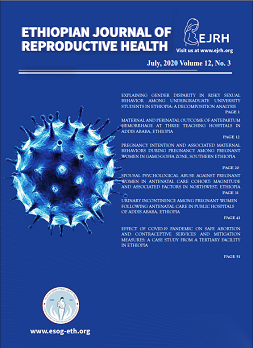Perinatal and Maternal Outcome of Antepartum Hemorrhage in Addis Ababa University
DOI:
https://doi.org/10.69614/ejrh.v12i3.395Abstract
Background
Any bleeding from the genital tract during pregnancy, after the period of viability until the delivery of the fetus (end of second stage), is defined as antepartum hemorrhage. Antepartum hemorrhage is an obstetric emergency contributing to a significant amount of perinatal & maternal morbidity and mortality.
Objective
To assess the perinatal and maternal outcomes of Antepartum hemorrhage.
Methodology
Facility based prospective cross sectional descriptive study was done from January to June 2018 on women with APH who delivered in Addis Ababa University. Pregnant women who were diagnosed to have antepartum hemorrhage and delivered in the three hospitals in the study period were included. Data was analyzed using SPSS 23 statistical software.
Results
There were a total of 9643 deliveries of which 358 women were diagnosed to have antepartum hemorrhage which accounts for 3.7%. Abruptio placenta was the most frequent diagnosis which was found in 221 women and constitutes 2.3% of all deliveries. Cesarean section was the most common route of delivery, 224 deliveries, which accounts for 62.5 %. The perinatal mortality rate was 15.8% (158 per 1000 birth). Fifty four (15%) of the mothers had developed postpartum hemorrhage. A total of 52(14.5%) women were diagnosed with anemia postpartum and there was one maternal death.
Conclusion
Antepartum hemorrhage is associated with high maternal and perinatal morbidity and mortality with an increased cesarean section rates, anemia, postpartum hemorrhage, preterm deliveries, low birth weight, NICU admission, intrauterine fetal death and perinatal mortality.
Key Words: Antepartum Hemorrhage, Maternal outcome, Perinatal outcome,



